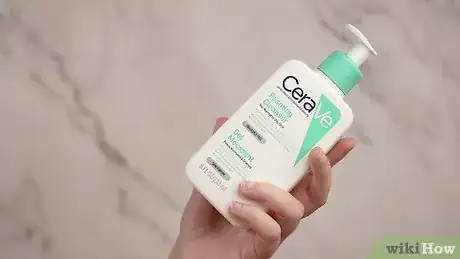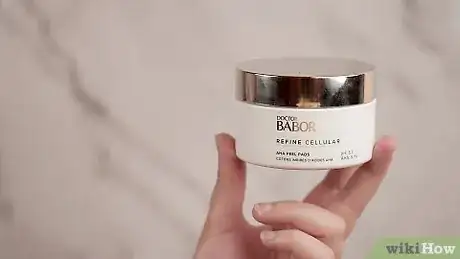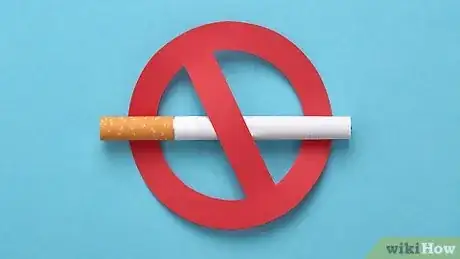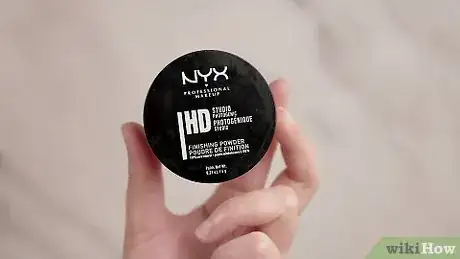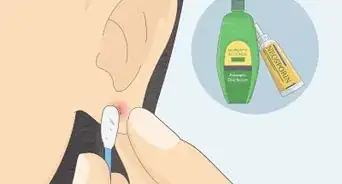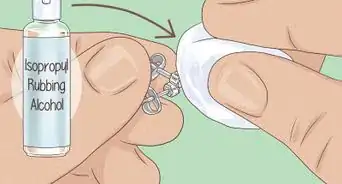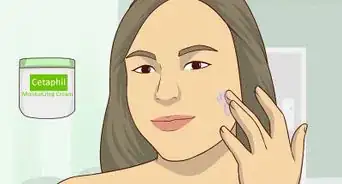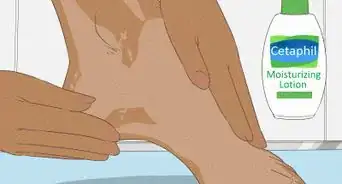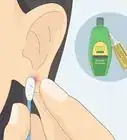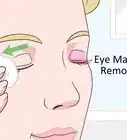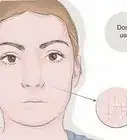This article was co-authored by Mohiba Tareen, MD. Mohiba Tareen is a board certified Dermatologist and the founder of Tareen Dermatology located in Roseville, Maplewood and Faribault, Minnesota. Dr. Tareen completed medical school at the University of Michigan in Ann Arbor, where she was inducted into the prestigious Alpha Omega Alpha honor society. While a dermatology resident at Columbia University in New York City, she won the Conrad Stritzler award of the New York Dermatologic Society and was published in The New England Journal of Medicine. Dr. Tareen then completed a procedural fellowship which focused on dermatologic surgery, laser, and cosmetic dermatology.
There are 12 references cited in this article, which can be found at the bottom of the page.
This article has been viewed 28,345 times.
Skin types run the gamut from oily to dry. It’s not uncommon to have patches of both oily and dry skin, also known as “combination skin.” Cleansing combination skin can be a bit tricky because it requires using different methods on different areas of your face.
Steps
Washing Combination Skin
-
1Determine whether or not you have combination skin. If your t-zone (your forehead, nose, and chin) is oily and tends to get blackheads and your cheeks are often dry and flaky, you have combination skin. [1]
- Try the tissue test. Press a tissue against your whole face for a few seconds. If there is oil along the t-zone when you take it away but none from your cheeks, you probably have combination skin.
- Combination skin is often genetic, but puberty can also affect your skin type. If you have combination skin as a teenager, you may grow out of it and need to change your cleaning routine.
-
2Choose a gentle, water-soluble cleanser. Gel-based and mild foaming cleansers work well for combination skin. Typically, bar soap isn’t a good idea, because it can clog pores and dry out skin. [2]
- Many people swear by the Dove Beauty Bar as a facial cleanser, so this may be the exception to the bar soap rule. Other gentle cleansers include Cetaphil and Noxzema.
- Some people find that the first few days of using a new product causes their skin to break out. You may have to stick with it for a few days or even a couple of weeks to determine whether the product you’re using is working for you.[3]
- Don’t use harsh cleansers. Anything with sulfate or alcohol in it will remove natural oils from your skin and cause breakouts.
Advertisement -
3Wash your face. Wet it with with lukewarm water. Use your fingertips to apply cleanser. Washcloths and sponges can irritate your skin. Rinse with lukewarm water and pat it dry with a towel.[4]
- Change your face towel often, since it can pick up bacteria, transfer that bacteria back to your face, and cause breakouts.
- Wash your face twice a day — once in the morning and once in the evening. Too much washing can cause irritation, so don't wash more often than that.
- Don’t skip washing your face, even for a day. Oils will build up in your t-zones and cause breakouts.
-
4Apply your acne medication. If you are acne-prone and have chosen an over-the-counter medication or your doctor has prescribed you one, put it on right after you wash your face. Use it very sparingly and only as directed. [5]
- Over-the-counter medicines with active ingredients such as benzoyl peroxide, salicylic acid, glycolic acid, or lactic acid kill the bacteria that causes acne.[6] They may also dry out your skin, so try to apply them only in the places where you are most acne-prone (probably the oily places).
- Medical treatments include the use of tretinoin and antibiotics. Antibiotics can make your skin sensitive to sunlight, so be careful when outside and wear a good sunblock.
-
5
-
6Exfoliate. Gentle exfoliation will get rid of dead skin cells. Try a product with beta hydroxy acid (BHA) in it, particularly for the oily parts of your face. BHA will both exfoliate and kill bacteria that cause acne.[9]
- Some companies, such as Clinique, offer multi-step skincare systems for different types of skin. This may come with cleanser, toner, and exfoliant made for your skin type.
-
7Choose a moisturizer designed for combination skin. You could use two different moisturizers, but it’s very easy to accidentally cross the barrier between you t-zone and cheeks. Instead, choose one meant to work on both types of skin. [10]
- Some experts suggest applying your combination moisturizer to the dry areas of your face twice a day and only once to the t-zone.
- Look for an acne product that says it is “non-comedogenic.” This means it will not cause acne and should be suitable for any skin type.
- Consider using a moisturize that contains an SPF as well.
Maintaining Healthy Combination Skin
-
1Exercise. Exercising causes your blood to pump vigorously around your body. Blood delivers nutrients to your skin.[11] Increased blood flow also helps flush cellular debris away, which helps your skin look and feel healthy. [12] Do exercises that get your blood pumping, including:
- Running
- Team sports
- Dancing
- Hiking
-
2Relieve stress. Stress causes the sebaceous glands in your skin to produce excess oil. People with combination skin may find that they have more acne on the oily parts of their face when they’re stressed, and eczema flare-ups on the dry parts of their face. [13] People under stress are known to break out more than those who are not stressed out. To relieve stress try:
- Meditation or yoga
- Exercise
- Deep breathing
- Listening to calming music
- Laughter yoga
-
3Eat foods that moisturize your skin. If you have combination skin, you may find that it’s a challenge to apply moisturizer to your face and avoid your t-zone. [14] Instead of adding a moisturizing product to your face, try to eat more:
- Salmon
- Walnuts
- Flaxseeds
- Celery
- Cucumber
- Eggs
- Quinoa
Avoiding Skin Irritants
-
1Protect your skin from the sun. Whether your skin is oily, dry, or a combination of both, it’s important to keep the sun off of it. Wear sunscreen and hats whenever you’re going to be outside for a long time.[15]
- Use sunscreen every day during every part of the year.[16]
- You may need two different sunscreens if you have combination skin. Choose an oil-free sunscreen for the oily part of your face. Choose one with active ingredients titanium dioxide or zinc oxide for the drier parts of your face.[17]
- The American Academy of Dermatology recommends a sunscreen with broad coverage of UVA and UVB sunlight. Further, they recommend SPF 30 or higher and suggest that you find a sunscreen that is water resistant.[18]
-
2Don’t smoke. Smoking deprives your skin of the nutrients it needs to look and feel healthy. It can exacerbate any problems that your skin already has. Smoking also makes it hard for your skin to heal when it gets wounded.[19] Additionally, some types of acne are worse in people who smoke.
-
3Choose makeup carefully. If you’re going to wear makeup, you’ll need to choose it carefully in order to address both the oily and dry parts of your skin.
- Cream-to-powder foundation is a good option. This kind of foundation goes on in the form of a cream but dries as a matte texture.
- If you want more coverage, opt for a light dusting of powder over your foundation. Many people with combination skin prefer a mineral-based makeup that is talc free.
- Traditional blush tends to work well on combination skin.
- People with combination skin should choose a powdered eye shadow.
- Touch up the oily parts of your skin with blotting papers during the day to control shine and prevent breakouts.
Expert Q&A
-
QuestionHow often should I wash my face if I have combination skin?
 Mohiba Tareen, MDMohiba Tareen is a board certified Dermatologist and the founder of Tareen Dermatology located in Roseville, Maplewood and Faribault, Minnesota. Dr. Tareen completed medical school at the University of Michigan in Ann Arbor, where she was inducted into the prestigious Alpha Omega Alpha honor society. While a dermatology resident at Columbia University in New York City, she won the Conrad Stritzler award of the New York Dermatologic Society and was published in The New England Journal of Medicine. Dr. Tareen then completed a procedural fellowship which focused on dermatologic surgery, laser, and cosmetic dermatology.
Mohiba Tareen, MDMohiba Tareen is a board certified Dermatologist and the founder of Tareen Dermatology located in Roseville, Maplewood and Faribault, Minnesota. Dr. Tareen completed medical school at the University of Michigan in Ann Arbor, where she was inducted into the prestigious Alpha Omega Alpha honor society. While a dermatology resident at Columbia University in New York City, she won the Conrad Stritzler award of the New York Dermatologic Society and was published in The New England Journal of Medicine. Dr. Tareen then completed a procedural fellowship which focused on dermatologic surgery, laser, and cosmetic dermatology.
FAAD Board Certified Dermatologist No matter what skin type you have, try to wash your skin or shower at least once a day and as soon as you can after doing strenuous activities that makes you sweat.
No matter what skin type you have, try to wash your skin or shower at least once a day and as soon as you can after doing strenuous activities that makes you sweat.
References
- ↑ http://www.everydayhealth.com/skin-and-beauty/whats-my-skin-type.aspx
- ↑ http://www.uwhealth.org/madison-plastic-surgery/the-benefits-of-drinking-water-for-your-skin/26334
- ↑ Mohiba Tareen, MD. FAAD Board Certified Dermatologist. Expert Interview. 26 March 2020.
- ↑ https://www.aad.org/public/skin-hair-nails/skin-care/face-washing-101
- ↑ http://www.webmd.com/skin-problems-and-treatments/teen-acne-13/10-tips-for-preventing-pimples
- ↑ Mohiba Tareen, MD. FAAD Board Certified Dermatologist. Expert Interview. 26 March 2020.
- ↑ Mohiba Tareen, MD. FAAD Board Certified Dermatologist. Expert Interview. 26 March 2020.
- ↑ http://www.paulaschoice.com/expert-advice/combination-skin/_/combination-skin-how-it-works#How
- ↑ http://www.paulaschoice.com/expert-advice/combination-skin/_/combination-skin-how-it-works#How
- ↑ http://www.annmariegianni.com/combination-skin-what-it-is-how-to-cope-and-the-best-products-for-you/
- ↑ http://www.annmariegianni.com/combination-skin-what-it-is-how-to-cope-and-the-best-products-for-you/
- ↑ http://www.webmd.com/skin-problems-and-treatments/acne/features/exercise
- ↑ http://www.webmd.com/skin-problems-and-treatments/acne/features/exercise
- ↑ http://www.huffingtonpost.com/2012/11/28/hydrating-foods-dry-skin-hair_n_2193919.html
- ↑ http://www.webmd.com/beauty/face/whats-your-skin-type?page=2
- ↑ Mohiba Tareen, MD. FAAD Board Certified Dermatologist. Expert Interview. 26 March 2020.
- ↑ http://www.paulaschoice.com/expert-advice/combination-skin/_/combination-skin-how-it-works#How
- ↑ https://www.aad.org/media/stats/prevention-and-care/sunscreen-faqs
- ↑ http://www.huffingtonpost.com/2013/11/25/cigarettes-and-skin-wrinkles_n_4323081.html

